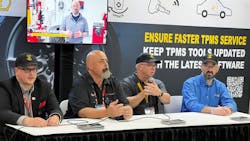When tire pressure monitoring systems (TPMS) were mandated into use in the U.S., Mariam Lochoshvili, global marketing communications manager for Schrader TPMS Solutions, says “TPMS added a new layer of safety for drivers.” But help lines to tool and sensor makers are lighting up with avoidable problems coming from technicians.
In the last decade TPMS service has become a regular piece of the service puzzle for tire independent tire dealers and other service repair shops, but Lochoshvili says there’s an increasing number of shops reporting problems with reset procedures not working properly. And TPMS sensor manufacturers are receiving returned parts under warranty claims that function perfectly fine.
The issue: technicians are using TPMS tools that lack the latest the latest software and vehicle updates. And without those updates, standard service tasks are snarled.
This issue is so great it has brought together a coalition of TPMS tool and sensor manufacturers and their collective launch of an educational campaign to ensure faster TPMS service.
The “Don’t wait, update” tagline is supported by ATEQ TPMS Tools LC, Bartec USA LLC, Continental Automotive Systems Inc. and Schrader TPMS Solutions. The group held a press conference at the 2023 Automotive Aftermarket Products Expo (AAPEX), and Schrader’s Lochoshvili served as emcee, speaking alongside an expert from each of the four companies.
But their flier breaks it down simply: “The newest generation of TPMS sensors needs the latest generation TPMS tool software. Without it, you can’t do TPMS service successfully.” The campaign’s website offers links to training to each of the companies’ update procedures.
Bartec’s Scot Holloway said more tools connect directly to the internet than when TPMS initially entered the aftermarket, and ATEQ’s Mike Rose said as more businesses invest in quality Wi-Fi for in-bay use, keeping tools updated should become an easier task.
Continental’s Sean Lannoo says while this campaign is focusing on keeping tools updated, he also sees TPMS tools in shops that aren’t charged and ready for use.
Yanick Leduc of Schrader says updated tools “will ensure you have the latest OE coverage, but also updates and small changes” that occur in older models. He noted depending on the vehicle, different trim levels will use different part numbers, making TPMS resets more complex. But all of these tweaks are reflected in the toolmakers’ regular updates.
Can’t these toolmakers automate the updates?
Rose says, “If you force the update, it might be at an inconvenient time.” A technician could be in the midst of using the tool when that auto update was rolled out.
Holoway says, “It’s a two way street,” and note another big hiccup to this process is that not all of the tools in service bays were registered at the outset. That means the tool manufacturer isn’t even able to email that particular user each time there’s an update available.
Lannoo says many of the help line calls Continental receives reveal the users “had no idea they even had updates available to them.”
Leduc says he thinks automated updates will be the ultimate solution — someday. “I think we need to get there.” For some users, Leduc says it’s been so long since they updated the tool “they don’t remember how to do the update.”
At a minimum, he suggests users download the available updates “at least once a month.”




